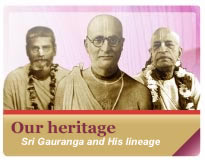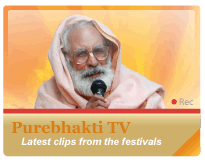
NASA Discovery and the Power of God’s Names
A report by Sripada Bhaktivedanta Madhava Maharaja
[NOTE: This page uses Balarama font (available here)
for better transliteration of Sanskrit into English]
My çikñä-gurudeva, Çré Çrémad Bhaktivedänta Näräyaëa Gosvämé Mahäräja, is preaching
the message of Çréman Mahäprabhu extensively throughout the countries of the East and West. While in Australia Mohenjo-Daro India
Indian culture is very ancient and was systematic, prosperous in every respect, and designed for people who observed proper moral conduct. Even if the modern scientists and archaeologists were to make a collective effort to try to understand its age, they would be baffled in their attempt.
The people of the West are far more advanced in technology and communications than are the people of India United States India
NASA Images Discover
(Courtesy: NASA Digital Image Collection)
Space images taken by NASA reveal a mysterious ancient bridge in the Palk Strait between India Sri Lanka Adam’s Bridge , is made of a chain of shoals, c. 18 miles (30 km) long.
The bridge’s unique curvature and composition by age reveal that it is man-made. According to both archaeological studies and legend, the first signs of human inhabitants in Sri Lanka
This information provides a crucial insight into the mysterious legend called “Ramayana”, which was supposed to have taken place in Treta-yuga, more than 1,700,000 years ago. In this epic there is mention of a bridge that was built between Rameshvaram in India
This information may be of little importance to the archaeologists interested in exploring the origins of man, but it is sure to open the spiritual floodgates as people across the world come to know of an ancient history linked to the Indian mythology.
After hearing this news report, a member of the audience asked my çikñä-guru Çré Çrémad Bhaktivedänta Näräyaëa Gosvämé Mahäräja, for his opinion on the report.
Çréla Mahäräjajé: This recent report by NASA has given a glimpse into the culture of ancient India
Member of the audience: Can you please say more about this, with examples so that the newcomers here may understand.
Çréla Mahäräjajé: The span of Indian, Vedic culture is given in the Vedic scriptures. According to Çrémad- Bhägavatam and other scriptures, the four yugas (Satya-, Tretä-, Dväpara- and Kali-yuga) form one divya-yuga. Seventy-one divya-yugas equal the duration of one manvantara. Fourteen manvantaras make up one day of Brahmä, whose night is of the same length. Brahmä has a year of 360 days, and a lifespan of one-hundred years.
During one day of Brahmä, maryäda-puruçottama Bhagavän Çré Rämacandra, lélä-puruçottama Bhagavän Çré Kåñëa and, in the Kali-yuga that follows Kåñëa’s appearance, prema-puruçottama Çré Çacénandana Gaurahari, descend to this world. However, Bhagavän Çré Rämacandra does not descend in the Tretä-yuga just previous to the Dvärpara-yuga in which Bhagavän Çré Kåñëa appears. It is beyond the ability of modern scientists to correctly calculate these events.
An Indian resident of Australia
Çréla Mahäräjajé: Listen. You are a scientist. One of our bhaktas pointed you out to me before class. At that time in ancient India India India
Collection)

Scientist: Swämijé, you have commented on the subject of advanced technology. Was there computer science during the time of ancient India
Çréla Mahäräjajé: Your question makes me laugh. Knowledge of Indian science is of a special type, meaning it comes from realization. Your knowledge, however, is devoid of realization and is not actual knowledge. In one way you people are innocent. Your family lineage is Indian but how can you possibly understand these things? Without the aid of ancient India
Scientist: Yes, I know of it. Even though I am a scientist, I try to study the Bhägavatam daily.
Çréla Mahäräjajé: I will give you an example of computer science from this Çrémad-Bhägavatam. Do you know the story of Çåëgi Åñi, the son of the Åñi Çaméka, who cursed King Paréksit at the mere age of five years?
Scientist: Yes, Swämijé, I do know it. I heard from my mother that due to this curse the Bhägavatam manifested in this world.
Çréla Mahäräjajé: Your mother has told you correctly. She must be a bhakta. No ordinary person can understand this secret; only devotees can do so. Immediately after this curse all the munis and åñis, taking a vow to fast until death, at once arrived on the banks of the Gaìgä with King Parékñit. The sage Maìgal from Mongolia Kaiçipayana Ocean India
Devotee: Gurudeva, We heard from you the glory of ancient Indian culture as described in Çrémad-Bhägavatam. At that time, you were speaking in relation to the glories of çré näma. What connection does näma have with NASA’s discovery? I don’t understand.
Çréla Mahäräjajé: The technology that was used to construct this bridge, which has been discovered by NASA, was näma technology and nothing else. At the time of building this bridge Nala, Néla, Hanumän and all others would place stones in the water while uttering Bhagavän’s names, “Räma, Räma”. By the influence of this name the stones did not sink; rather they all joined together.
In their childhood Nala and Néla were very mischievous; they used to throw the sages’ kuça-äsanas and other possessions into the water, thus causing them to sink. The sages became angry and declared, “Anything you throw into the water will float.” There was so much power in the words of those näma-paräyaëa sages (sages who are fully devoted to Bhagavän’s holy name) that anything Nala and Néla threw into the water refused to sink. This curse became a benediction for them, just as the curse of näma-paräyaëa Åñi Närada upon the two sons of Kuvera, Nalaküvara and Maëigréva, enabled them to attain Vrajendra-rénandana Çyämasundara.
If näma-paräyaëa Deva Åñi had not cursed Nalaküvara and Maëigréva, they would not have attained Bhagavän.
The potency of näma can not only create a bridge on the ocean to enable Çré Räma’s
army to cross over it, but is so great that it can even build a bridge for the jéva to cross over this ocean of nescience and reach his real home. Other than näma technology, no technology has this ability. This is the real glory of näma.

Sunrise at Dhanuñakoöi, the place in Rämeçvaram from where Lord Rämacandra’s army built the bridge to Çré Lankä.
Rays of the Harmonist
No. 12 Gaura Purnima 2003http://bvml.org/contemporary/NASA.html




Nenhum comentário:
Postar um comentário